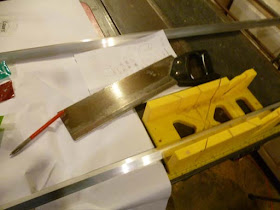I wanted an overhead camera mount that I could disassemble and move around easily, though the final result has slightly more screws than anticipated.
An overhead camera mount lets me capture any drawing or desktop work head on, avoiding any angles.
Of course you could mount steel pipe and flanges to a sturdy work table, but I wanted this mobile. Making this mobile does sacrifice rigidity, but as long as you have a solid work table rigidity isn't much of a concern.
A steel pipe camera mount bolted to a table would run ballpark $150-170. It will also be much heavier.
The cost is dependent on what you have on hand. I only had to buy the aluminum and wing nuts. I spent less than $80, but if you have to buy all the screws this will run you about $100. The upside is you'll be stocked with screws for plenty of future projects.
Materials Required:
- (6) 6'-0" lengths of 1/2"x1/2"x1/16" aluminum angle
- (18) 10-32 x 1/2" screws
- (12) 10-32 hex nuts
- (6) 10-32 wing nuts
- (1) 1/4-20 x 1/4" socket cap screw for camera and nut (check your camera for thread type)
When recording, I use a 2x3 piece of carpet for a good frame of reference of what the camera actually captures to keep the work 'on camera.'
The big kicker is how solid your work surface is. If that's sturdy, the frame will remain pretty still. If your work table is rickety, you'll run into issues with camera shake.
Tools Used:
- Miter saw/box or chop saw with metal cutting blade
- Metal punch/hammer
- C-clamps and 90* corner clamps
- Drill or drill press and assorted drill bits
- Socket wrench to tighten bolts
- File to smooth aluminum edges
(4) 24" lengths
(4) 48" lengths
(3) 42" lengths
(2) 6" lengths
Aluminum is fairly easy to cut. While you could use a metal cutting blade, it's not required and has a relatively wide kerf. I used a file to smooth any rough edges and burrs incurred from the cuts.
The angles were bolted with 10-32 screws and nuts at each corner. I used 10-32 screws and wing nuts for the three lengths across the top. When you mark for screws across the top, be sure you're clear of the side frame screws. The idea is that I can unscrew the wing nuts and pack this relatively flat.
Buying screws/nuts online is usually cheaper than a big box store plus you get a 100 pack instead of a dozen, which means on the next project you'll already have the screws and save yourself a few bucks.
I built the 24"x48" sides first. I clamped the frame together with corner clamps before drilling holes. Drilling through both angles ensure holes line up. Use a punch to mark where to drill and prevent the drill from walking. Once the hole is drilled use a file to clean up
Once the side frames are built use a c-clamp to attached the cross braces. Punch the holes and drill.
Aluminum is a soft metal. If drilling through isn't happening pretty quickly it's likely your drill bit is dull.
I braced opposite corners of the vertical frame to the horizontal angles with 6" lengths of angle and 10-32 screws. If I had more aluminum I would have braced all four corners.
I clamped the braces in place and drilled through both angles at the same time.
Bracing just the two corners made the frame significantly sturdier. I'm satisfied with that result.
To make this even sturdier, run a 42" brace across the bottom to each leg. Only do this on one side, as you need to access one side and a bar could get in the way of your work.
A 1/4-20 screw holds the camera in place. I used a spacer since the screw I had on hand was 3/4" long. I added a nut for when the camera isn't mounted so the screw doesn't fall out of the hole.
I can capture any table top work with ease and I can move this mount around as needed. I may eventually add an angle across the bottom at the back and brace that just to further reduce any flex.











No comments:
Post a Comment